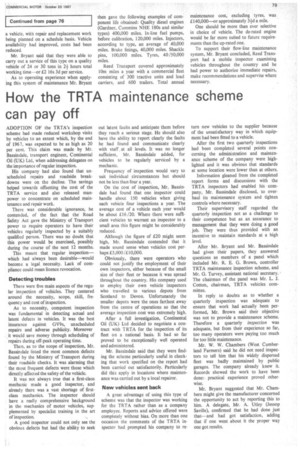Saving money and legal troubles with flow-line servicing
Page 78

Page 81

If you've noticed an error in this article please click here to report it so we can fix it.
"NOW THAT standards have been laid down it is quite certain that lip service only to the [Road Safety] Act will no longer be tolerated". With this warning Mr. A. J. Bryant, fleet engineer, Reed Transport Ltd. underlined the importance of the paper with which he opened the afternoon session on Friday. It was entitled: "Vehicle Maintenance in the 1970s".
He told delegates that in previous Acts words such as "reasonable" and "acceptable" had been used—and abused—by manufacturer and operator alike. .Hence there were many vehicles now operating that required modification to braking systems to reach even the interim efficiency standards.
Now that there was to be a specification for both new vehicle construction and operating efficiency level, manufacturers would all be competing on the same basis and, Mr. Bryant forecast, operators should get a better class of chassis.
From recent advice given by manufacturers it was apparent that many braking systems were marginal, to say the least. In future, vehicles would be subject to both annual tests and road-side checks, and with marginal brakes it was obvious that maintenance staff would need to be on their toes for wear and adjustment.
Vital brake balance
The roller type machine that was expected to be used at the Ministry of Transport testing stations would record individual wheel and axle braking efficiency but not a combination of axles. It was therefore essential, Mr. Bryant continued, that maintenance staff made certain that the two sides of an axle were evenly balanced because an unequal reading could cause a rejection.
But if a vehicle were stopped on the road a different form of brake test could take place which would cover the combined efficiency of all axles and, if there was a time lag between them, the overall efficiency could be reduced. It was therefore up to maintenance staff to check, adjust and eliminate time lag as far as possible.
Before submission to test, all working parts of a vehicle must be made reasonably clean and thoroughly checked. A badly "caked" vehicle could be rejected because of the difficulty of inspection.
In the past there had been differences of opinion as to degree of wear. In the future, and possibly by the time the tests take place, a standard of wear would be agreed upon.
One often heard the statement "a calculated risk". This was nonsense, Mr. Bryant exclaimed: if there had been a risk it should have received attention.
For many years routine maintenance had been geared to lubrication and oil changes and, where automatic lubrication systems had been fitted, much had been taken for granted. But now with bigger, heavier and faster vehicles this phraseology had lost its meaning. Regular inspection was essential.
In future, maintenante records would be inspected in much the same way as drivers' log-sheets. The Ministry would be revoking far more licences than hitherto where vehicles collected GV9s as the result of poor maintenance. Maintenance records were relatively simple—but on their own were not sufficient because the vehicle would be the corroborating evidence.
Braking systems were becoming more and more complex and needed trained personnel for their maintenance. It was wrong, Mr. Bryant contended, to use drivers as fitters unless they had training. They should not be involved with rectification of working parts.
Mr. Bryant warned delegates that previously neglected trailers would now play a much greater part in overall braking efficiency. Modifications were available to improve the MH type of coupling combination by means of air or vacuum lines. But the wedge brakes normally used on these trailers would require frequent adjustment.
A basic principle adopted by Reed for carrying out phased services in off-peak hours on a 3,000-mile cycle was that a vehicle was divided into components on a service inspection sheet and the job was carried out by a flow-line method so that no one fitter was responsible for the entire inspection or service. The checking part of the service was carried out by the person responsible for the component, but if there was a defect it was not rectified at that stage.
Reduce defects—and delays
It was the duty of the person responsible for the line to pass the vehicle on for rectification according to his judgment of need. His company had found since the introduction of this method that minor defects which had often caused irritating delays had been very much reduced.
The most important point to be gained from this system, Mr. Bryant said, was that a "progressive wear" log could be kept for a vehicle, with repair and replacement work being planned on a schedule basis. Vehicle availability had improved, costs had been reduced.
Mr. Bryant said that they were able to carry out a service of this type on a quality vehicle of 24 or 30 tons in 2+ hours total working time—or £2 16s 3d per service.
As to operating experience when applying this system of maintenance Mr. Bryant then gave the following examples of component life obtained: Quality diesel engines (Gardner, Cummins NHE 180s and similar types) 400,000 miles. In-line fuel pumps, before calibration, 120,000 miles. Injectors, according to type, an average of 40,000 miles. Brake linings, 40,000 miles. Shackle pins, 100,000 miles. Tyres, 40/50,000 miles.
Reed Transport covered approximately 10m miles a year with a commercial fleet consisting of 300 tractive units and load carriers. and 600 trailers. Total annual
maintenance cost, excluding tyres, was £140,000—or approximately 3+d a mile.
One should be more than ever selective in choice of vehicle. The de-rated engine would be far more suited to future requirements than the up-rated one.
To support their flow-line maintenance system, Mr. Bryant concluded, Reed Transport had a mobile inspector examining vehicles throughout the country and he had power to authorize immediate repairs, make recommendations and supervise where necessary.








































































































































